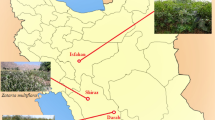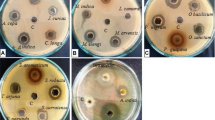Abstract
This study aimed to evaluatein vitro effects ofRheum undulatum L. root on the development of dental caries, especially its effects on viability, dental plaque formation, and glycolytic acid production ofStreptococcus mutans andStreptococcus sobrinus. Methanol extract ofRheum undulatum L. root and its fractions were prepared and tested. Among the test extract and fractions, dichloromethane fraction (DF) showed the most active antibacterial activity (inhibition zone: 13–17 mm) againstS. mutants andS. sobrinus in a disc diffusion method. Minimal inhibitory concentrations (MICs) of DF against these bacteria ranged from 0.25 to 0.5 mg/mL. Furthermore, DF significantly inhibited the caries-inducing factors of these bacteria. At sub-MIC levels, DF inhibitedin vitro dental plaque formation byS. mutans andS. sobrinus (IC50=0.079 and 0.142 mg/mL, respectively), which was caused, in part, by the inhibitory effect on the activity of glucosyltransferases. A significant reduction of glycolytic acid production was found at the concentration as low as 0.032 mg/mL forS. mutans and 0.063 mg/mL forS. sobrinus. The possible bioactive compounds that are inducingin vitro anti-cariogenic activity of DF are unknown. Based on the preliminary phytochemical analysis, the activity of DF may be related to the presence of anthraquinones, cardiac glycosides, coumarines, sterols/terpenes, and phenolics. These results indicate that DF is probably useful for the control of dental plaque formation and subsequent dental caries development.
Similar content being viewed by others
References
Cos, P., De Bruyne, T., Hermans, N., Apers, S., Berghe, D. V., and Vlietinck, A. J., Proanthocyanidins in health care: current and new trends.Curr. Med. Chem., 11, 1345–1359 (2004).
Eley, B. M., Antibacterial agents in the control of supragingival plaque-a review.Br. Dent. J., 27, 286–296 (1999).
Fejerskov, O., Scheie, A. A., and Manji, F., The effect of sucrose on plaque pH in the primary and permanent dentition of caries-inactive and-active Kenyan children.J. Dent. Res. 71, 25–31 (1992).
Gaffar, A., Afflitto, J., and Nabi, N., Chemical agents for the control of plaque and plaque microflora: an overview.Eur. J. Oral Sci., 105, 502–507 (1997).
Gibbons, S. and Gray, A., Isolation by Planar Chromatography,In Cannell, R. P. (Ed). Natural Products Isolation. Humana Press Inc, New Jersey, pp. 209–245, (1988).
Hajishengallis, G. and Michalek, S. M., Current status of a mucosal vaccine against dental caries.Oral Microbiol. Immunol., 14, 1–20 (1999).
Hamada, S., Horikoshi, T., Minami, T., Okahashi, N., and Koga, T., Purification and characterization of cell-associated glucosyltransferase synthesizing water-insoluble glucan from serotype cStreptococcus mutans.J. Gen. Microbiol., 135, 335–344 (1989).
Hamada, S. and Slade, H. D., Biology immunology, and cariogenicity ofStreptococcus mutans.Microbiol. Rev., 44, 331–384 (1980).
Hamada, S. and Torii, M., Effect of sucrose in culture media on the location of glucosyltransferase ofStreptococcus mutans and cell adherence to glass surfaces.Infect. Immun., 20: 592–599 (1978).
Hashimoto, K., Yanagi, K., Fukushima, K., and Uda, Y., Effect of 3-hydroxymethylene-2-thioxopyrrolidine on growth of two species of mutans streptococci and theirin vitro plaque formation.Int. J. Antimicrob. Agents, 17, 97–102 (2001).
Havsteen, B., Flavonoids, a class of natural products of high pharmacological potency.Biochem. Pharmacol., 32, 1141–1148 (1983).
Hur, J., Dong-Eui-Bo-Gam Vol. VI. Yeogang Press, Seoul, pp. 519–526, (1994).
Jagtap, A. G. and Karkera, S. G., Extract ofJuglandaceae regia inhibits growth, in vitro adherence, acid production and aggregation ofStreptococcus mutans.J. Pharm. Pharmacol., 52, 235–242 (2000).
Kakuta, H., Iwami, Y., Mayanagi, H., and Takahashi, N., Xylitol inhibition of acid production and growth of mutans Streptococci in the presence of various dietary sugars under strictly anaerobic conditions.Caries Res., 37, 404–409 (2003).
Ko, S. K., A new stilbene diglycoside fromRheum undulatum.Arch. Pharm. Res., 23, 159–162 (2000).
Ko, S. K., Lee, S. M., and Whang, W. K., Anti-platelet aggregation activity of stilbene derivatives fromRheum undulatum.Arch. Pharm. Res., 22, 401–403 (1999).
Koo, H., Gomes, B. P., Rosalen, P. L., Ambrosano, G. M., Park, Y. K., and Cury, J. A.,In vitro antimicrobial activity of propolis andArnica montana against oral pathogens.Arch. Oral Biol., 45, 141–148 (2000).
Koo, H., Pearson, S. K., Scott-Anne, K., Abranches, J., Cury, J. A., Rosalen, P. L., Park, Y. K., Marquis, R. E., and Bowen, W. H., Effects of apigenin and tt-farnesol on glucosyltransferase activity, biofilm viability and caries development in rats.Oral. Microbiol. Immunol., 17, 337–343 (2002).
Lee, J. H., Kim, J. M., and Kim, C., Pharmacokinetic analysis of rhein inRheum undulatum L.J. Ethnopharmacol., 84, 5–9 (2003).
Loesche, W. J., Role ofStreptococcus mutans in human dental decay.Microbiol. Rev., 50, 353–380 (1986).
Madison, K. M., Bowen, W. H., Pearson, S. K., and Falany, J. L., Enhancing the virulence ofStreptococcus sobrinus in rats.J. Dent. Res., 70, 38–43 (1991).
Matsumoto, M., Minami, T., Sasaki, H., Sobue, S., Hamada, S., and Ooshima, T., Inhibitory effects of oolong tea extract on caries-inducing properties of mutans streptococci.Caries Res., 33, 441–445 (1999).
Mehansho, H., Butler, L. G., and Carison, D. M., Dietary tannins and salivary proline-rich proteins: interactions, induction, and defense mechanisms.Annu. Rev. Nutr., 7, 423–440 (1987).
Mukasa, H., Tsumori, H., and Shimamura, A., Isolation and characterization of an extracellular glucosyltransferase synthesizing insoluble glucan fromStreptococcus mutans serotype c.Infect. Immun., 49, 790–796 (1985).
Ojala, T., Remes, S., Haansuu, P., Vuorela, H., Hiltunen, R., Haahtela, K., and Vuorela, P., Antimicrobial activity of some coumarin containing herbal plants growing in Finland.J. Ethnopharmacol., 73, 299–305 (2000).
Rasheed, A. and Haider, M., Antibacterial activity ofCamellia sinensis extracts against dental caries.Arch. Pharm. Res., 21, 348–352 (1998).
Sahin, F., Karaman, I., Gulluce, M., Ogutcu, H., Sengul, M., Adiguzel, A., Ozturk, S., and Kotan, R., Evaluation of antimicrobial activities ofSatureja hortensis L.J. Ethnopharmacol., 87, 61–65 (2003).
Sreenivasan, P. and Gaffar, A., Antiplaque biocides and bacterial resistance: a review.J. Clin. Periodontol., 29, 965–974 (2002).
Tanzer, J. M., Dental caries is a transmissible infectious disease: the Keyes and Fitzgerald revolution.J. Dent. Res., 74, 1536–1542 (1995).
Wagner, H. and Bladt, S., Plant Drug Analysis: A Thin Layer Chromatography Atlas (2nd edn). Springer, Berlin, pp. 349–364 (2001).
Wiater, A., Choma, A., and Szczodrak, J., Insoluble glucans synthesized by cariogenic streptococci: a structural study.J. Basic Microbiol., 39, 265–273 (1999).
Yang, D. Y., Fushimi, H., Cai, S. Q., and Komatsu, K., Molecular analysis ofRheum species used as Rhei Rhizoma based on the chloroplastmatK gene sequence and its application for identification.Biol. Pharm. Bull., 27, 375–383 (2004).
Author information
Authors and Affiliations
Corresponding author
Rights and permissions
About this article
Cite this article
Song, JH., Yang, TC., Chang, KW. et al. In vitro anti-cariogenic activity of dichloromethane fraction fromRheum undulatum L. root. Arch Pharm Res 29, 490–496 (2006). https://doi.org/10.1007/BF02969422
Received:
Issue Date:
DOI: https://doi.org/10.1007/BF02969422




